Blessed be all. I was searching the net and found an article on tarot and journals. I found this article on tarot journaling to be very informative and interesting and I wanted to share it with you all. I hope you enjoy it as much as I did. I keep a sort of tarot diary, and I am going to write this down in it, for future inspiration.
*************************************************************************************
Tarot Journaling
From "Tarot Journaling: Using the Celtic Cross to Unveil Your Hidden Story" by Corrine Kenner
Posted by: DailyOM
What Covers You
Turn up the top or first card of the pack; cover the Significator with it, and say: This covers him. This card gives the influence which is affecting the person or matter of inquiry generally, the atmosphere of it in which the other currents work.
-arthur edward waite,
The Pictorial Key to the Tarot (1910)
Atmosphere and Influences
When Arthur Edward Waite first conceptualized his tarot deck, he hired a young artist named Pamela Colman Smith to illustrate each card. She was a fellow member of the Order of the Golden Dawn, a mystical group that truly believed in the importance of atmosphere: they met in a space designed to look like an ancient Egyptian pyramid, and dressed in elaborate costumes with robes and headpieces.
Pamela Colman Smith had a theater background, so she fit right in. Earlier, she had designed sets, costumes, and programs for England's Royal Lyceum Theatre when it toured the United States-and she brought her flair for the dramatic to the tarot cards she painted. In fact, when you look through the Rider-Waite-Smith deck, you might notice that many of the cards look like costumed actors posing on a stage.
Your own backdrop and surroundings can play a crucial role in your journaling practice. If you want to get the most out of each performance, you might want to think about setting the stage and ushering in a little atmosphere.
Location, Location, Location
Where should you write in your tarot journal? You might like to work in a quiet room-especially if you plan to combine a full-fledged tarot reading with your writing, and privacy is an issue. In that case, a bedroom, a den, or a quiet corner in the yard is perfect. You might prefer to work where there is a buzz or hum of activity-where you can see the archetypes of the tarot come alive in the guise of busy strangers going about their business, and you can overhear stimulating snippets of conversation. Cafés, restaurants, coffee shops, libraries, and hotel lobbies are all good places to journal.
Honestly, you can write in your tarot journal anywhere you like, as long as you can immerse yourself fully in the tarot cards and in the pages of your journal-an area many tarot readers refer to as sacred space.
Sacred Space
Many tarot readers routinely clear a sacred space for their tarot readings. The process is simple: they clear away clutter and distractions, light candles, and visualize pure white light filling their reading area.
Some tarot readers go a step further and establish a dedicated reading area. Many tarot readers like to enhance that sacred space with symbolic representations of the four suits and their corresponding elements, such as candles for fire, chalices for water, soothing background music for air, and crystals for earth.
In a similar fashion, tarot journaling should incorporate the four realms of your experience: spiritual, emotional, intellectual, and physical. Tarot journaling should also be a holistic experience that integrates all of your senses: sight, hearing, smell, taste, and touch.
The imagery and colors of the cards, of course, will please your sense of sight. Beautiful background music will uplift your spirit. Scented oils, candles, or incense will stimulate your sense of smell. A glass of water, coffee, tea, or wine will appeal to your sense of taste. And the weight of your journal in your hands or on your lap will put you in physical contact with your sense of touch.
Because the work you do in your tarot journal originates in your mind, however, you have one option that isn't open to you when you conduct a tarot reading. When you write in your tarot journal, you can work with sacred space that's based more in your inner world than in your outer reality. You might think of it as imaginary sacred space-except for the fact that it will seem more real to you every time you visit.
You might choose a scene from a tarot card as the basis for your sacred space. You might envision yourself in the Nine of Pentacles garden, for example, or the seaside balcony in the Two of Wands. You can either select a card at random or choose the card you most want to use.
Your sacred space also can be an idealized space that you picture in your mind's eye: the den, library, tea parlor, or landscape of your dreams. You might even find a photo in a magazine and use that as inspiration.
Imaginary sacred space is ideal for journaling, because it can travel with you. Imaginary sacred space is always ready for you to close your eyes and step inside-and cleanup is quick and easy. In addition, fantasy sacred space has the added benefit of preparing you to someday discover or create your ideal sacred space in the real world.
Ritual and Routine
Tarot reading rituals help smooth the way for tarot readings, by eliminating decisions about where you should sit, how you should shuffle, or how you should open a reading. Likewise, a few well-designed journaling rituals will help you get the preliminaries out of the way, calm you, and free you to start the creative process of writing.
Here are some techniques you can try as part of your journaling routine.
Light a candle. Gaze into the flame for a few minutes before you begin writing.
Enjoy your favorite drink. Feel yourself relax with every sip, and imagine it filling you with energy.
Try four-part breathing. Inhale, and hold your breath for five seconds. Then exhale, and again hold your breath for five seconds. As you breathe, imagine yourself becoming more relaxed and, simultaneously, more rejuvenated. Let the fresh air permeate every cell of your being. Inhale to recharge. Exhale to dispel tension and negativity.
Progressive relaxation. Consciously relax every part of your body, from head to toe.
Ground yourself. Put both feet on the floor. Imagine that you are a tree, with roots reaching far underground and branches reaching toward the heavens.
Starting Points
You might want to begin each entry the same way, so you don't waste any time composing your first few words.
Greet your audience. Dear Diary is cliché, but it works. You might also address each entry directly to the audience you have in mind. You might be writing your journal for your current self or your future self. You might imagine yourself writing to your children, your grandchildren, your students, your therapist, or your support group. You might be talking to your partner-past, present, or future. You might be writing to a friend-either someone you know now, someone you used to know, or someone you hope to meet.
Date the page. Include the time of day and your location.
Mood lighting. Write about your mood and the reason for your attitude. Recap the events of your day so far.
Draw a card. Choose a card from your tarot deck, and write its title on the page.
Shortcuts and Abbreviations
In tarot journaling, you might find yourself writing many of the same phrases, words, and titles over and over again. You can take shortcuts, like the abbreviations and shorthand that follow. If you choose to develop your own tarot timesavers, create a key and keep it with your journal.
Major Arcana Abbreviations
You can refer to Major Arcana cards by their Arabic numbers or Roman numerals, both of which are usually printed on the cards, and both of which are fairly standard and consistent from deck to deck. The only exception is Strength and Justice-cards 8 and 11. In some decks, depending on the artist's preference, Strength is 8 and Justice is 11. In other decks, that's reversed. In your journal, you might need to note which deck you're using.
arabic roman major arcana
number numeral card
0 0 The Fool
1 I The Magician
2 II The High Priestess
3 III The Empress
4 IV The Emperor
5 V The Hierophant
6 VI The Lovers
7 VII The Chariot
8 VIII Strength (sometimes Justice)
9 IX The Hermit
10 X The Wheel of Fortune
11 XI Justice (sometimes Strength)
12 XII The Hanged Man
13 XIII Death
14 XIV Temperance
15 XV The Devil
16 XVI The Tower
17 XVII The Star
18 XVIII The Moon
19 XIX The Sun
20 XX Judgement
21 XXI The World
Minor Arcana Abbreviations
You can use abbreviations for cards in the four suits of the Minor Arcana: typically W for wands, C for cups, S for swords, and P for pentacles. If your wands are called rods, use an R. If your wands are called staffs, distinguish them from swords by writing St and Sw. If pentacles happen to be called coins in your deck, use a cents symbol (¢) instead of the letter C. You get the idea.
When you abbreviate the names of court cards, be sure to distinguish between Knights and Kings by using the abbreviations Kn for Knights and K for Kings.
wands cups swords pentacles
Ace AW AC AS AP
Two 2W 2C 2S 2P
Three 3W 3C 3S 3P
Four 4W 4C 4S 4P
Five 5W 5C 5S 5P
Six 6W 6C 6S 6P
Seven 7W 7C 7S 7P
Eight 8W 8C 8S 8P
Nine 9W 9C 9S 9P
Ten 10W 10C 10S 10P
Page PW PC PS PP
Knight KnW KnC KnS KnP
Queen QW QC QS QP
King KW KC KS KP
If you prefer, you can also devise glyphs or symbolic illustrations to designate specific cards. You might note your wands as straight lines (!) or exclamation marks (!), cups as circles (o), swords as arrows (), and pentacles as stars or asterisks (*). You could even rely on playing-card symbols, and denote wands as clubs (), cups as hearts (TM), swords as spades (´), and pentacles as diamonds (©).
Reversed Cards
Many tarot readers note reversed cards with the n symbol-a shortcut borrowed from astrologers, who use it to refer to retrograde planets. (Those are planets that appear, from Earth's vantage point, to be moving backward.)
Astrological glyphs can be useful additions to a tarot journal. Astrological references are built in to most tarot cards. The glyphs are not difficult to memorize, especially once you realize that they actually look like the symbol they represent.
Astrological Glyphs
glyph sign. (representation.) card.
a Aries, the ram. (A ram's horns.) The Emperor.
b Taurus, the bull. (A bull's head.) The Hierophant.
c Gemini, the twins. (Twins, side by side.) The Lovers.
d Cancer, the crab. (A crab's claws.) The Chariot.
e Leo, the lion. (A lion's mane.) Strength.
f Virgo, the virgin. (MV, the Virgin Mary's initials.) The Hermit.
g Libra, the scales. (Balanced scales.) Justice.
h Scorpio, the scorpion. (A scorpion's stinger.) Death.
i Sagittarius, the archer. (An arrow.) Temperance.
j Capricorn, the goat. (A mountain goat.) The Devil.
k Aquarius, the water-bearer. (Waves of water or air.) The Star.
l Pisces, the fish. (Two fish, kissing.) The Moon.
[ The Sun, luminary of light and illumination. (The center of the universe.) The Sun.
@ The Moon, luminary of reflection and receptivity. (A crescent moon.) The High Priestess.
O Mercury, planet of speed and communication. (A magician in a horned headpiece.) The Magician.
T Venus, planet of love and beauty. (A woman's hand mirror.) The Empress.
N Mars, planet of energy and force. (Directed energy, an arrow.) The Tower.
M Jupiter, planet of luck and expansion. (The fourth planet from the Sun, the number four.) The Wheel of Fortune.
R Saturn, planet of boundaries, tradition, and limitations. (A traditional church with a steeple and cross.) The World.
S Uranus, planet of rebellion and independence. (A man doing a handstand.) The Fool.
P Neptune, planet of glamour and illusion. (The sea god's trident.) The Hanged Man.
Q Pluto, planet of unavoidable change and regeneration. (A P and an L, the first two letters of Pluto.) Judgement.
Checklists
You can save time during a journaling session by using a checklist to record pertinent facts about your tarot readings. The following list of possible checklist entries is extensive; don't try to incorporate all of it. Just pick and choose from the items on this list that truly interest you.
Some of the items you might want to include in your reading records include:
The date
The time
Your location
Astrological data (Sun sign, Moon phase, planetary retrogrades, void-of-course Moon data)
The reader's name, if you are getting a reading from a friend
The querent or questioner's name, if you are reading the card for another person
The question or concern
The name of the deck
The name of the spread
The cards in each position of the spread
Encouraging cards
Discouraging cards
Surprising cards
Clarification or wild cards
Number of Major Arcana cards
Number of Minor Arcana cards
Significant details
Keywords and phrases
Numerical significance and interpretation
Interesting pairs and combinations
Predominant suits and elements
Predominant colors
Missing suits and elements
Positive interpretations
Negative connotations
Intuitive response
Spiritual response
Emotional response
Intellectual response
Physical response
Themes (elemental, numerical, astrological, or kabbalistic)
Hebrew letter
Kabbalistic sephiroth
Kabbalistic pillar
Color scale
Additional questions developed during the course of the reading
Insights
Conclusion(s)Fill in the Blanks
If you truly want to keep a quick and easy tarot journal, you might want to develop standard fill in the blank pages to document most of your readings. You can use any page design software to create forms like the ones in appendix V, print as many copies as you need, and keep them in a three-ring binder. You can also find downloadable versions of each page online at www.tarotjournaling.com.
© Llewellyn Worldwide Ltd.
Welcome to my online Book of Shadows.
A good place to come and learn from and share with like-minded Pagans and Wiccans of all Traditions.
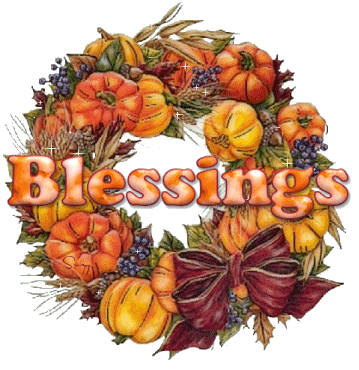
glitter-graphics.com

glitter-graphics.com
Wiccan Rede
Wednesday, September 3, 2008
Subscribe to:
Post Comments (Atom)
Live Traffic Feed
Being

Breath

Courage

Fight for Freedom
Earth Air Fire Water
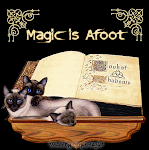
Talisman
Spellwork
Moon Goddess
Moon Phases
CURRENT MOON
Blessed be
Musick of the Libri Umbra
Sun and Moon Positions
Get Your FREE Tarot Card Reading Here!
Get Your FREE I Ching Reading
Your Daily Rune
Daily I Ching
Today's I Ching
| The present is embodied in Hexagram 43 - Kuai (Resolve): It is required that the culprit's guilt be exhibited in the royal court, along with a sincere and earnest appeal for sympathy and support, with consciousness of the peril involved in cutting off the criminal. He should also make announcement in his own city, and show that it will not be well to have recourse at once to arms. In this way there will be advantage in whatever he shall go forward to. More details... |
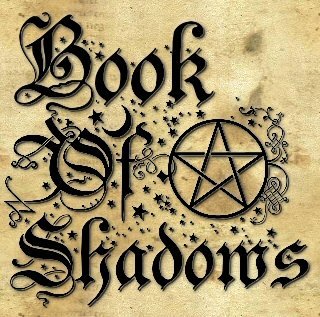





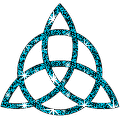
















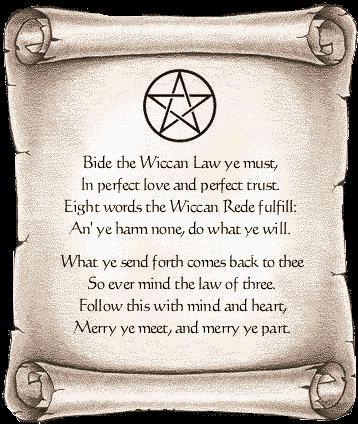








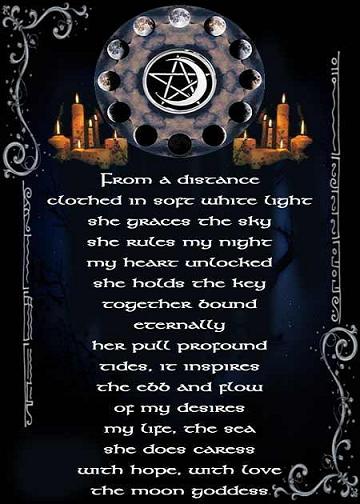

2 comments:
I have this book - I bought it around Yule and have gotten about halfway through reading it. I have a few pages of a Tarot Journal, as in whenever I do a reading I write it all in one book. I like re-reading my readings - they help me to better understand current readings. But one of my goals for this year is to keep a daily Tarot Journal.
Brightest Blessings!
Blessed be.
I am working on starting a tarot journal now as well. I bought this really nice leather-bound book at Wal-Mart that I am going to use.
I would love to get a copy of this book myself, but I have not yet seen it at my local bookstore. However, I can have them order it for me.
Have a great week.
Post a Comment